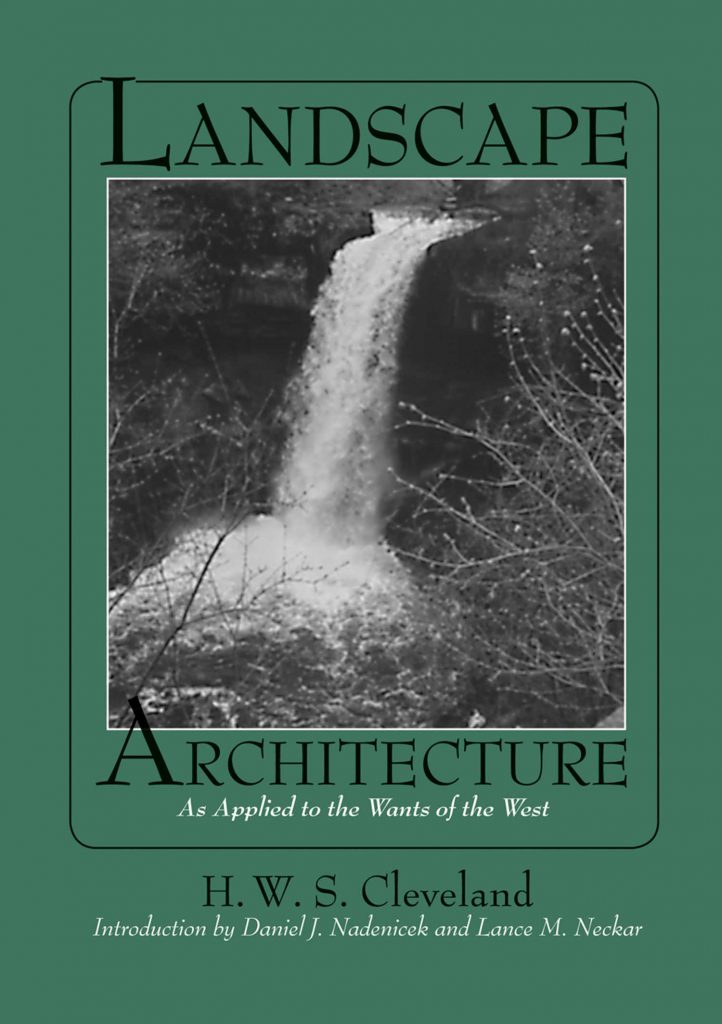Landscape Architecture, as Applied to the Wants of the West
with an Essay on Forest Planting on the Great Plains
H. W. S. Cleveland
Reprint of 1873 edition, with a new introduction by Daniel J. Nadenicek and Lance M. Neckar
Library of American Landscape History
| ISBN: 978-1-952620-03-4 | 224 pages | 5 x 7 inches |
| $30.00 | Cloth | Cloth | Published: 03/27/2002 |
| 19 b&w photos and drawings | |
Order Online
A volume in the ASLA Centennial Reprint Series
H. W. S. Cleveland’s Landscape Architecture, as Applied to the Wants of the West, published in 1873, summarizes Cleveland’s organic approach and its application at all scales of design and planning. The book is especially significant as the first attempt to define and develop a comprehensive scope for the new profession of landscape architecture in its formative period.
A new introduction to the text provides a historical backdrop to Cleveland’s concern that ill-considered layouts for communities along the rapidly developing rail lines of the Midwest and Great Plains would negatively affect what he saw as the future of American civilization. Daniel J. Nadenicek and Lance M. Neckar explicate Cleveland’s text, analyzing his innovative approach to design and planning and its influence on the profession. They also examine the intriguing, rarely studied Essay on Forest Planting on the Great Plains, the second part of the original book, discussing the pragmatic and philosophical forces that inspired its writing. The introduction provides an overview of Cleveland’s career, from his formative Unitarian roots in Lancaster, Massachusetts, through his designs for Highland Park in Illinois, the South Park System in Chicago, and, in his later years, the Minneapolis park system.
“The reprint and its perceptive introduction should help landscape historians give Cleveland the recognition he rightly deserves as one of America’s foremost pioneering landscape architects.”
About the Authors
H. W. S. Cleveland
An important force in nineteenth-century American landscape architecture, H. W. S. Cleveland (1814–1900) has long been overshadowed by Frederick Law Olmsted, with whom he worked briefly at Prospect Park. Cleveland’s “organic” design approach was first expressed in 1855 at Sleepy Hollow Cemetery in Concord, Massachusetts, where he and Robert Morris Copeland developed a landscape aesthetic based chiefly on the writings of Ralph Waldo Emerson.
Daniel J. Nadenicek
Daniel J. Nadenicek is dean of the University of Georgia’s College of Environment and Design and holds the Constance Knowles Draper Chair in Environmental Design. Nadenicek’s publications include more than ninety articles, reviews, reports, and proceedings in the areas of historic preservation, landscape history, and urban design. He is writing a book for LALH about the conservation work of Frederick Billings, financier and president of the Northern Pacific Railway.
Lance M. Neckar
Lance M. Neckar, a professor of landscape architecture at the College of Architecture and Landscape Architecture, University of Minnesota, Twin Cities, Neckar has received numerous awards for excellence in teaching. He serves as coeditor of Landscape Journal.
